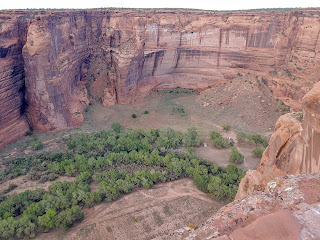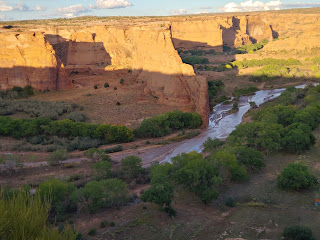We scheduled a Jeep Tour of the Canyon DeChelly (the bottom, not the rim) for the early afternoon. So we hung out for the morning -- me doing a couple loads of laundry at the laundromat across the road, and Peter on his blog.
The driver for the jeep tour picked us up at our hotel. When he got out of the very dirty, muddy, open air jeep, my initial judgmental impression kicked in. He was very overweight, old, and wobbled from side to side as he walked. Shame on me. It turns out he was a Navajo who grew up in Canyon DeChelly, and has been doing these jeep tours since they began in 1989. So he knew a lot about the Canyon, and even took us by the ranch in the Canyon where his aunt lives. He had many stories, and knew much of the geology. Since it had rained the day before, the run off had formed rivers in the canyon bottom. This is where the jeeps usually drive, as it is usually just hard-packed sand. So he needed to drive along side, sometimes, but had to drive right through the running water. It was sometimes a couple feet deep. Interesting enough, it turns out that the mud forms a thin, mostly impermeable layer on top of the sand, so the water just runs off, and doesn't sink in. So, it doesn't create deep mud and the tires just drove on through the stream. It was a bit scary though heading straight into the stream. No wonder the jeep was so muddy,
It was very different seeing the canyon cliff layers from the bottom, versus from a rim overlook. The bottom floor of the canyon was rather green--with green trees and grasses. There was even some farming being done there. Since this is a National Monument, and not a National Park, the Navajo tribe has ownership access to some of the bottom land. The duties of the National Monument staff is to protect the Monument. In this case, there are about 2700 Anastasi, Hopi, Spanish and some Navajo ruins and petroglyphs throughout the canyons, that are being protected.
It was amazing to me to see high up on a ledge, under an overhang, the ruins of Anastasi buildings. Built around 350 to 1300AD. They are still there, along with many of the petroglyphs on the walls. How they got up on the ledge every day would be quite challenging. There had been some ladders and foot holes in the cliff walls. We were told that they pulled up the ladders at night, and were protected from flash floods, animals and invasion by other tribes. They even had cisterns to collect the rain run off from the overhead cliffs. On either side of their buildings were black run off marks, showing where the water ran down from overhead, but not over their protected overhangs.
After the jeep tour, we drove the south rim, and stopped at about 5 different overlooks. A couple had short trails that you needed to walk to, to get to the overlook. My favorite was Spider Rock and Face Rock overlook. Spider Rock is two tall spires that look nothing like a spider. We were told that Spider woman lived on top of the rocks, and it was she that taught the Dine (Navajo) ancestors the art of weaving upon a loom. The dark side of the legend is that from the elders, the children learned that if they did not behave, spider woman would let down her web ladder and carry them up to her home and devour them. Their bones were what created the white bands of stone at the top of the spires. Their version, I guess, of the boogey-man. A little ways from Spider Rock is Face Rock. It looks like the profile of a woman (if you close one eye and squint the other), looking towards Spider Rock. It was said she was on the look out for misbehaving children.
Another delightful overlook was Sliding House Overlook. which looks into the green valley below. Each of the other overlooks were interesting vistas, looking into the various valleys and canyons. Again, from the top of the plateaus, driving to the next overlook, you would never know there was a 1000 foot canyon just across the prairie. A nice end to our stay here.
Jeep tour of Canyon DeChelly photos:
 |
| Crossing this stream in the jeep, many times |
 |
| Anastasi ruins along the ledge |
 |
| More ruins under the overhang |
Spider Rock and Face Rock photos:
 |
| Spider rock (the two towers) |
 |
| Face Rock (in profile) |



















No comments:
Post a Comment